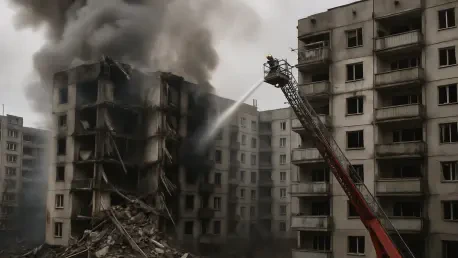The building safety crisis gripping Wales has cast a dark shadow over the lives of countless leaseholders residing in high-rise flats, leaving them trapped in a distressing cycle of uncertainty and fear. Despite the Welsh Government’s introduction of a building safety pact aimed at ensuring fire safety in buildings taller than 11 meters, the initiative has been met with sharp criticism for its glaring shortcomings. Leaseholders, supported by advocacy groups such as Welsh Cladiators, are increasingly vocal about their frustration with unsafe living conditions and the financial devastation of owning properties they cannot sell. This crisis not only threatens their physical well-being but also erodes their financial stability and mental health. Delving into the reasons behind the pact’s failure reveals systemic issues, from sluggish remediation efforts to a lack of accountability for developers. This article explores the multifaceted challenges leaseholders face and why a policy intended to protect them appears to be falling short of its critical objectives.
Stalled Progress in Safety Remediation
The Welsh Government’s ambitious safety program encompasses 461 high-rise buildings across the region, yet the pace of remediation has been dishearteningly slow, fueling widespread concern among affected residents. As of the latest data in July, a mere 43% of these buildings have either completed or ongoing remediation work, with only four out of 161 private sector structures fully addressed. This glacial progress has led to fears among leaseholders that delays could extend well into 2030 or even further, prolonging their exposure to hazardous living conditions. Stories emerging from communities in Cardiff and Swansea paint a grim picture of families and individuals caught in a state of limbo, unable to plan for the future while their homes remain potential fire risks. The lack of a concrete timeline for completion exacerbates the uncertainty, leaving many to question whether the government’s commitment to safety is matched by actionable results.
Beyond the raw numbers, the slow remediation pace reflects deeper logistical and administrative bottlenecks that hinder effective action. Developers often cite complex legal processes or supply chain issues as reasons for delays, but leaseholders argue that such excuses mask a lack of urgency. For residents, each passing month without progress means continued risk and diminished trust in the system designed to protect them. The stark contrast between the scale of the problem and the limited advancements made so far underscores a critical flaw in the safety pact’s execution. While the government points to ongoing discussions with stakeholders as evidence of effort, the tangible impact on the ground remains minimal. This persistent gap between policy and practice has left many leaseholders feeling abandoned, with their safety concerns seemingly sidelined in favor of bureaucratic inertia.
Weak Enforcement Mechanisms in the Pact
A core criticism leveled against the Welsh Government’s building safety pact, implemented in recent years, centers on its apparent lack of robust enforcement mechanisms to ensure developer compliance. Leaseholders and advocacy groups have described the agreement as fundamentally flawed, lacking the strict deadlines and penalties necessary to hold developers accountable for timely remediation. Residents from areas like Cardiff have voiced their discontent, with individuals such as Marc Harries labeling the pact as unfit for purpose due to its inability to compel action. The government’s preference for a softer, more collaborative approach with developers has been criticized as overly lenient, allowing companies to delay essential safety works without facing significant repercussions. This perceived weakness in the pact’s framework has fostered a sense of betrayal among those who expected stronger governmental oversight.
The absence of enforceable consequences within the pact has created an environment where developers face little pressure to prioritize safety upgrades, further deepening leaseholder frustration. Without clear punitive measures, such as financial penalties or legal ramifications, there is minimal incentive for companies to expedite their efforts. This issue is compounded by the fact that leaseholders often lack the means to challenge delays independently, leaving them reliant on a system that appears to favor industry interests over resident safety. The government’s assurances of monitoring compliance do little to alleviate concerns when tangible progress remains elusive. Until stricter measures are integrated into the pact, the cycle of delays and inaction is likely to persist, undermining the very purpose of the initiative and leaving high-rise residents vulnerable to ongoing risks.
Devastating Personal and Financial Impacts
The human cost of the building safety crisis in Wales cannot be overstated, as leaseholders grapple with profound financial and emotional challenges stemming from the pact’s shortcomings. Many find themselves unable to sell their flats due to unresolved safety issues, rendering their properties virtually worthless while they remain burdened by substantial mortgage payments. The emotional toll is equally severe, with countless reports of sleepless nights, anxiety, and relentless stress over mounting debts and an uncertain future. Legal fees add another layer of financial strain, as residents are forced to navigate complex disputes with developers without the resources to match their counterparts’ expertise. This multifaceted hardship has transformed homeownership from a source of stability into a persistent source of despair for many across the region.
Adding to the personal burden is the frustration of dealing with developers who often prolong negotiations through last-minute contract changes or procedural delays. Leaseholders describe feeling trapped in a nightmarish cycle where their homes, once seen as safe havens, now represent both a physical danger and a financial liability. The psychological impact of living in buildings deemed unsafe for years on end cannot be ignored, as it erodes mental well-being and strains family dynamics. While the Welsh Government has acknowledged these struggles, the lack of immediate relief or protective measures for leaseholders continues to exacerbate the crisis. Until policies address both the economic and emotional dimensions of this issue, residents will remain caught in a distressing limbo, unable to move forward with their lives or secure their futures.
Systemic Imbalance Between Residents and Developers
A significant factor contributing to the building safety crisis is the stark power imbalance between leaseholders and developers, which leaves residents at a severe disadvantage. Lacking the legal expertise and financial resources to effectively challenge industry giants, many leaseholders feel helpless as developers cite intricate contractual or legal hurdles to justify inaction on safety works. This dynamic fosters a perception that corporate interests are prioritized over the urgent needs of residents, with companies appearing to drag their feet without consequence. The frustration is palpable in communities where leaseholders see their safety concerns dismissed or delayed by processes they cannot influence. This disparity not only stalls remediation but also deepens the sense of injustice among those most affected by the crisis.
Compounding this imbalance is the apparent reluctance of the government to intervene decisively on behalf of leaseholders, allowing developers to maintain the upper hand in negotiations. Residents often find themselves outmaneuvered in discussions over remediation contracts, facing tactics that prolong delays and increase costs. The systemic nature of this issue points to a broader failure to level the playing field, leaving leaseholders to bear the brunt of a crisis they did not cause. While some developers may face pressure through public scrutiny, the lack of formal mechanisms to enforce accountability means that change remains slow. Addressing this disparity requires not just policy adjustments but a fundamental shift in how resident rights are safeguarded against industry inertia, ensuring that safety is not negotiable or subject to corporate convenience.
Urgent Need for Robust Government Intervention
Amid growing discontent with the current state of building safety efforts, a resounding call for stronger government action has emerged from leaseholders and local officials alike. Advocates, including Cardiff councillors, are pushing for stricter legislation that would impose binding deadlines and financial penalties on developers who fail to comply with remediation requirements. The belief is that only by targeting companies’ bottom lines can the government spur the urgency needed to address unsafe buildings. Leaseholders argue that voluntary agreements have proven insufficient, as evidenced by the minimal progress made under the existing pact. This unified demand for tougher measures reflects a deep-seated frustration with a system that appears to lack the resolve to protect vulnerable residents from prolonged risk.
Skepticism persists despite the Welsh Government’s claims of actively monitoring compliance and engaging with developers to expedite safety works. Many residents and local leaders see little evidence of decisive action on the ground, with enforcement remaining more theoretical than practical. The gap between governmental assurances and the lived experiences of leaseholders highlights the need for a more aggressive approach to policy implementation. Without concrete penalties or mandatory timelines, the risk of further delays looms large, potentially extending the crisis for years. Bridging this divide will require not only legislative reform but also a commitment to prioritizing resident safety over industry leniency, ensuring that the pact evolves into a tool of genuine protection rather than a symbol of unmet promises.
Moving Toward Tangible Solutions
Reflecting on the building safety crisis in Wales, it becomes evident that the Welsh Government’s pact has fallen short of its intended goals, leaving leaseholders in a precarious and disheartening situation. The slow pace of remediation, coupled with weak enforcement, has perpetuated a cycle of delay and despair for countless residents. Financial and emotional burdens have weighed heavily on those affected, while a systemic power imbalance with developers has further entrenched their vulnerability. Calls for stronger intervention have grown louder, driven by a shared recognition that voluntary measures alone are inadequate to address the scale of the problem.
Looking ahead, actionable steps must be prioritized to rectify these failures and restore trust among leaseholders. Implementing stricter legislation with clear penalties for non-compliance could compel developers to act swiftly. Additionally, establishing support mechanisms, such as legal aid for residents, might help balance the power dynamics in negotiations. The government should also consider setting firm deadlines for remediation, backed by regular public updates on progress, to ensure transparency. These measures, if pursued with urgency, could transform the safety pact into a meaningful safeguard, offering hope to those who have endured years of uncertainty and paving the way for a safer future in high-rise living.









